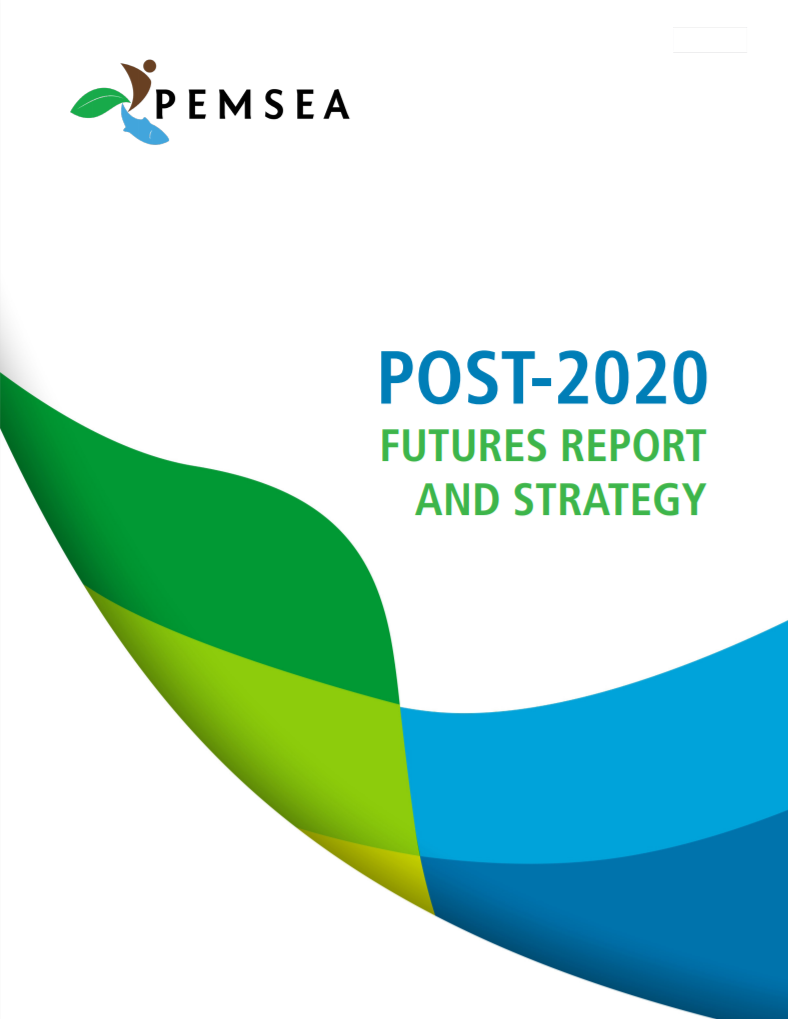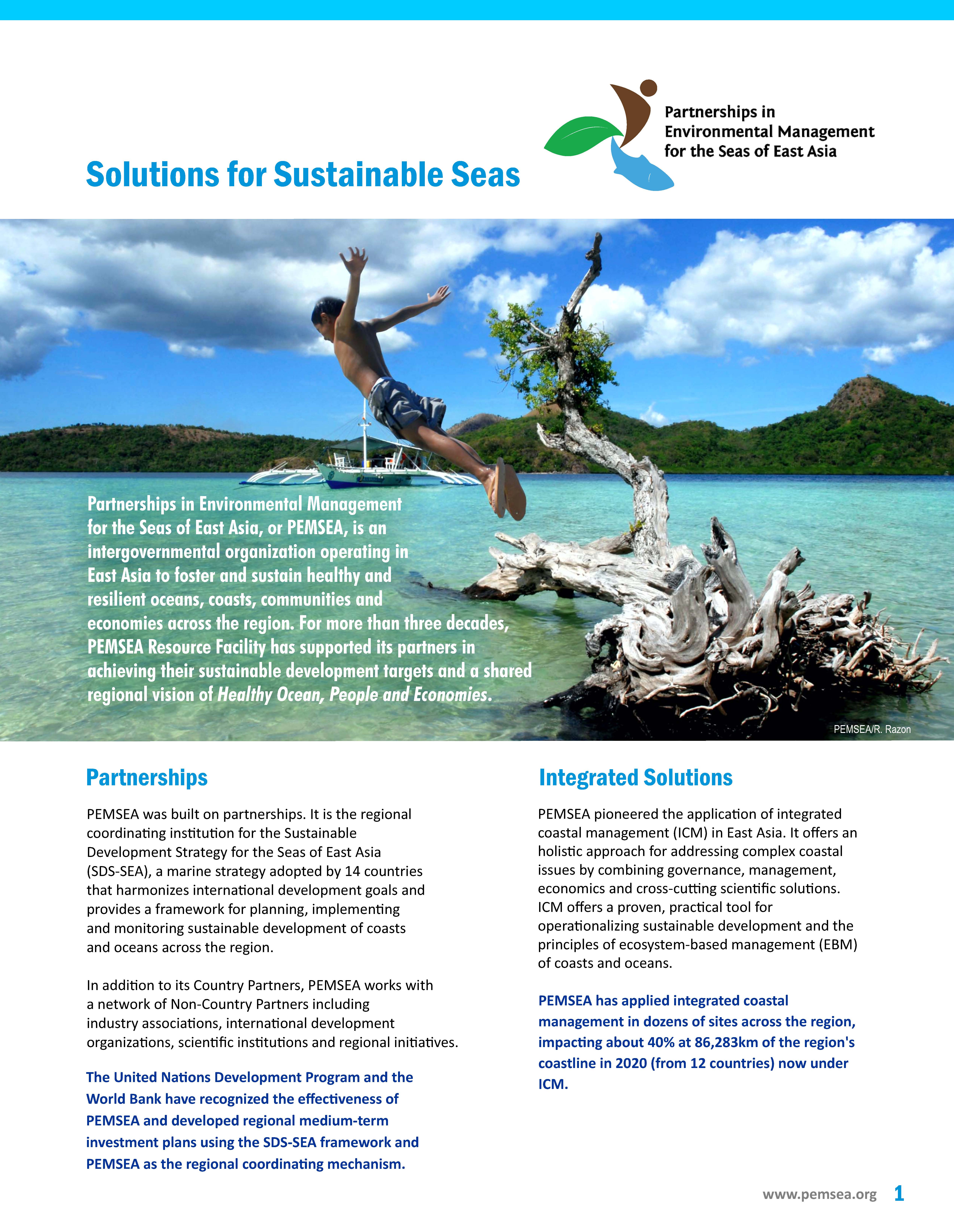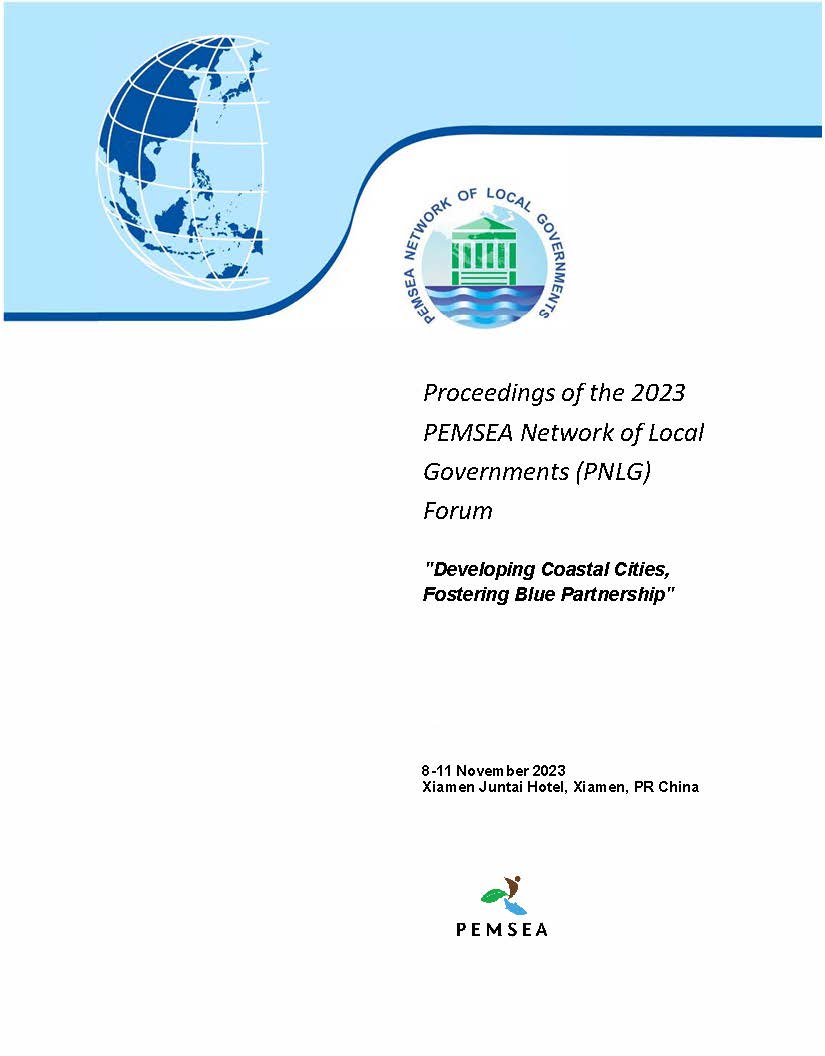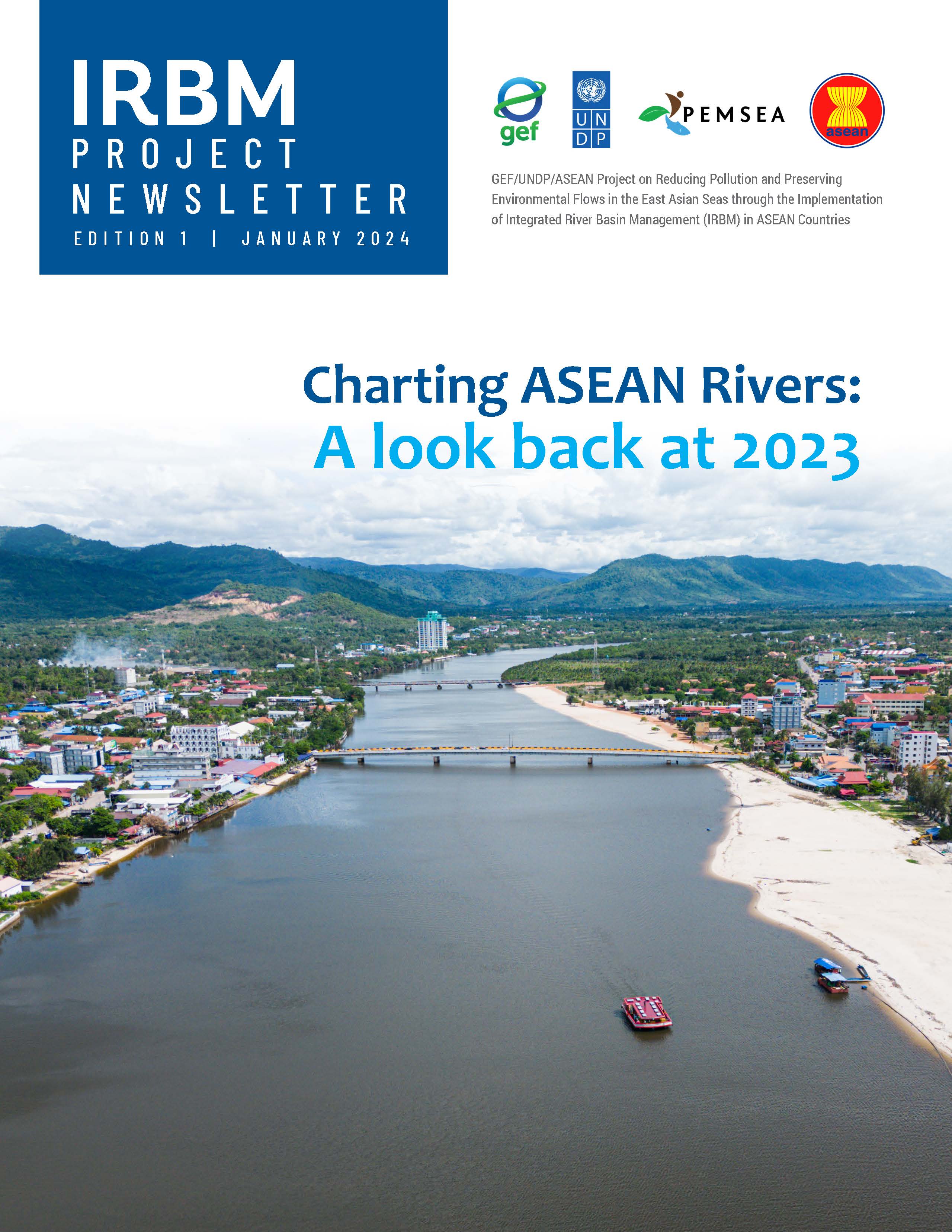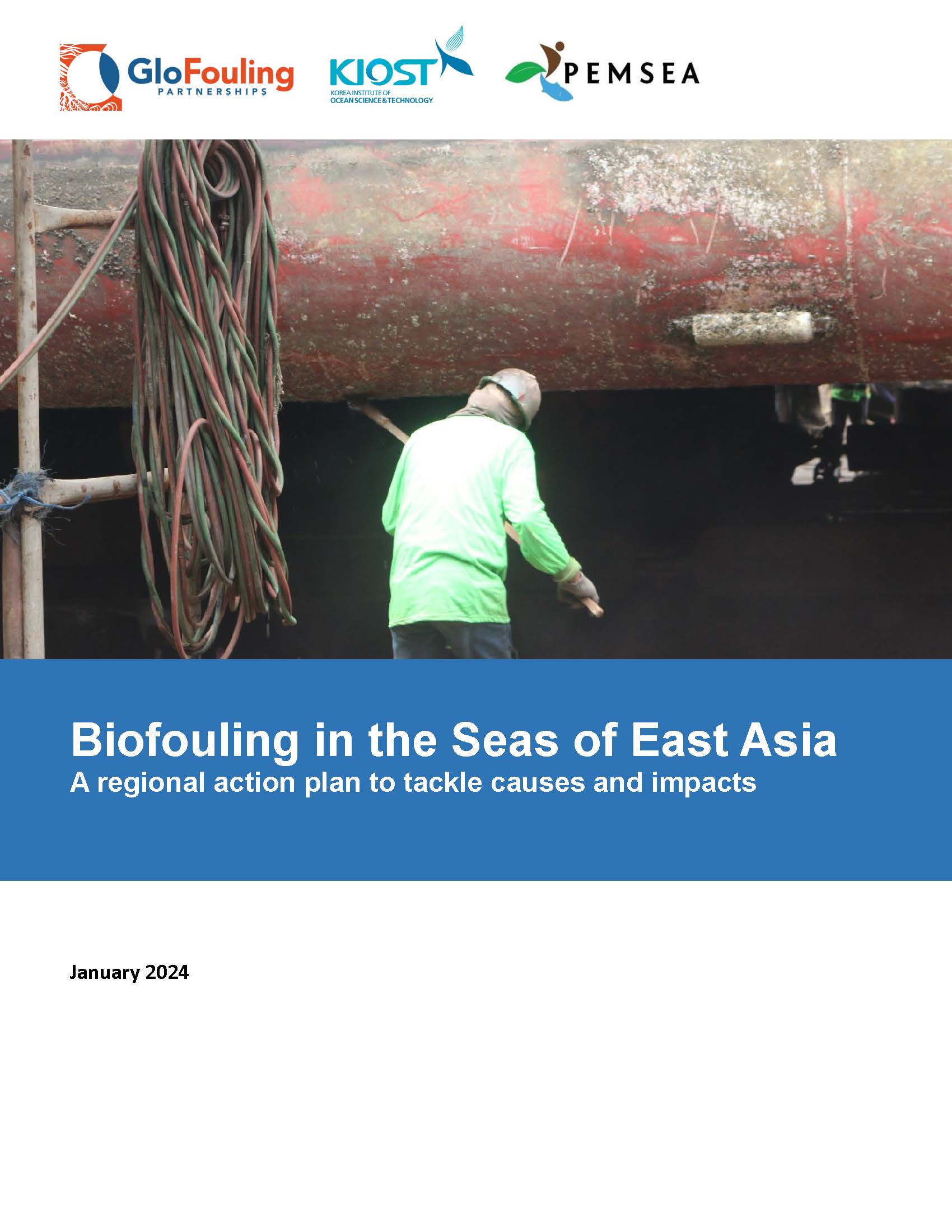
Breadcrumb
Post-2020 Futures Report and Strategy
PUBLICATION DATE:
Thursday, October 31, 2019
PUBLICATION TYPE:
Reports
STATUS:
Only Available Online
DESCRIPTION:
The East Asian Seas cover approximately 7 million km2 of sea area and 235,000 km of coastline. It is recognized as the center of marine biodiversity globally, being home to 31% of the world’s mangroves, 33% of seagrass beds and a third of the world’s coral reefs. Countries in the East Asian region account for 80% of global aquaculture, and around 60% of the world’s capture fisheries. The region’s seas serve as an important conduit for world trade, connecting 9 of the world’s 10 busiest ports. Moreover, the region is a center of economic growth, home to the 2nd and 3rd largest economies of the world (China and Japan, respectively), and the combined economies of ASEAN, which represent the world’s 5th largest economy and the 3rd largest global market with more than 630 million people.
Partnerships in Environmental Management for the Seas of East Asia (PEMSEA) is a regional organization mandated to promote collaboration towards healthy oceans, people and economies in the East Asian Seas (EAS). Eleven country partners and 21 non-country partners have been working together to implement a shared regional strategy called the Sustainable Development Strategy for the Seas of East Asia (SDS-SEA), which outlines ambitious targets and approaches towards ensuring sustainable and prosperous oceans and coasts in the region.
The adoption of the United Nations Sustainable Development Goals (UN-SDGs) in 2015 called on the public and private sectors and civil society to focus their efforts and partnership towards addressing the interrelated challenges of sustainable development, with the view of scaling-up solutions and managing resources more effectively. The same is taking place in East Asia as policies, programs, and projects are being aligned in support of the SDGs across the domains of government, business and finance, civil society, development funding and philanthropy.
As PEMSEA celebrates 25 years of helping strengthen regional governance and cooperation, building local capacity and implementing integrated coastal management (ICM), it now looks to the future. Stepping into a post-2020 world, this report seeks to identify the relevant global, regional and national trends that will catalyze change and influence decision-making for the EAS. In this report, key facts and figures on persistent and emerging trends and priority developments present both familiar and new perspectives on the challenges and opportunities that are likely to matter post-2020. This report is part of the process of stocktaking with a view to developing an action plan (roadmap) that would cover both mid- and long-term programs of work. The report’s aim is to help inform PEMSEA’s effective and collaborative engagement towards more sustainable and prosperous oceans and coasts.
RELATED PUBLICATIONS
-
Proceedings of the 2023 PEMSEA Network of Local Governments Forum (PNLG) "Developing Coastal Cities, Fostering Blue Partnership"
The 2023 Forum of the PNLG with the theme, “Developing Coastal Cities, Fostering Blue Partnership” was hosted by the PNLG and PEMSEA and co-organized by the PNLG Secretariat, PEMSEA Resource Facility (PRF) and Coastal and Ocean Management Institute (COMI) of Xiamen University (XMU). The forum was conducted on 8-11 November 2023 in Xiamen, China. The PNLG Forum was one of the key events of the Xiamen World Ocean Week.
The Forum was participated by over 130 participants from:
- 23 members from seven countries, namely: Cambodia, China, Indonesia, Malaysia, Philippines, RO Korea, and Timor Leste,
- 4 PNLG Associate members, namely the First Institute of Oceanography, Ministry of Natural Resources, China; Coastal and Ocean Management Institute (COMI) and Fujian Institute for Sustainable Oceans (FISO) of Xiamen University (XMU), China, and National Ocean Technology Center (NOTC) of the Ministry of Natural Resources, China;
- resource speakers and other invited experts,
- the PNLG Secretariat, and
- the PRF.
-
Proceedings of PEMSEA Network of Learning Centers (PNLC) back - to - back Events
The document contains the proceedings of three back-to-back activities that were conducted in Seoul, Republic of Korea from 31 October to 3 November 2023.
The activities include:
- The 6th Geo Blue Planet Symposium on Digital Solution for Sustainable Ocean Community on October 31
- PEMSEA Learning Exchange on Good Practices in Implementing Biodiversity Conservation-Focused Ecosystem and Area-based Management Approaches on November 1
- The 3rd PEMSEA Network of Learning Centers (PNLC) General Assembly Meeting on November 2
The activities were organized by the PEMSEA Resource Facility (PRF) with support from RoKorea Ministry of Ocean and Fisheries, the Korea Maritime Institute (KMI), and the Korea Management Corporation (KOEM), and the Korea Blue Carbon Research Center.
Participants include 39 representatives from 17 of the 21 PNLC members, officers, and staff from KMI, KOEM, the Korea Blue Carbon Research Center, and the PEMSEA Resource Facility (PRF).
-
Integrated River Basin Management Project Newsletter - Edition 1
2023 marks the beginning of a breakthrough collaboration among six ASEAN member states (AMS) and development partners in Southeast Asia for the protection and management of select priority river basins that drain into four large marine ecosystems in the Southeast Asian Region, the Bay of Bengal, South China Sea, Gulf of Thailand and Indonesian Sea. This year, the Integrated River Basin Management Project saw the project inception and establishment of the governance mechanism at the regional level, including the establishment of the Regional Project Management Unit at PRF and the approval and adoption of the 2023 workplan and budget. The six AMS proceeded in securing approval of the project in line with their respective government policies and procedures and initiated consultations at national and river basin levels to discuss the project’s implementing arrangements. Regional activities were also initiated including the development of State of River Basin Reporting Guidelines, Gender Equality and Social Inclusion Analysis, capacity development activities, and knowledge management and communication outreach.
-
Biofouling Management in the Seas of East Asia Regional Action Plan
The challenges posed by biofouling require responses at local, national, and regional levels. The link to international shipping is crucially important, especially so in East Asia, which is already the global hotspot for shipping despite continuing advances in its economies. During the regional meeting of the GloFouling Partnerships Project in September 2023, the Regional Action Plan on Biofouling Management was approved as a response to the need.
